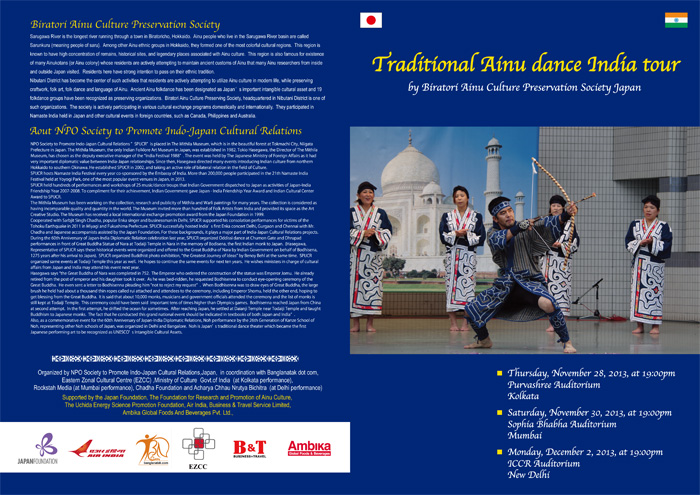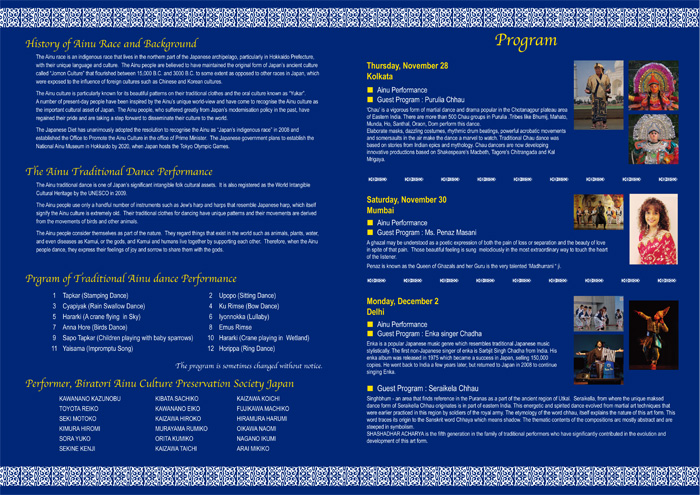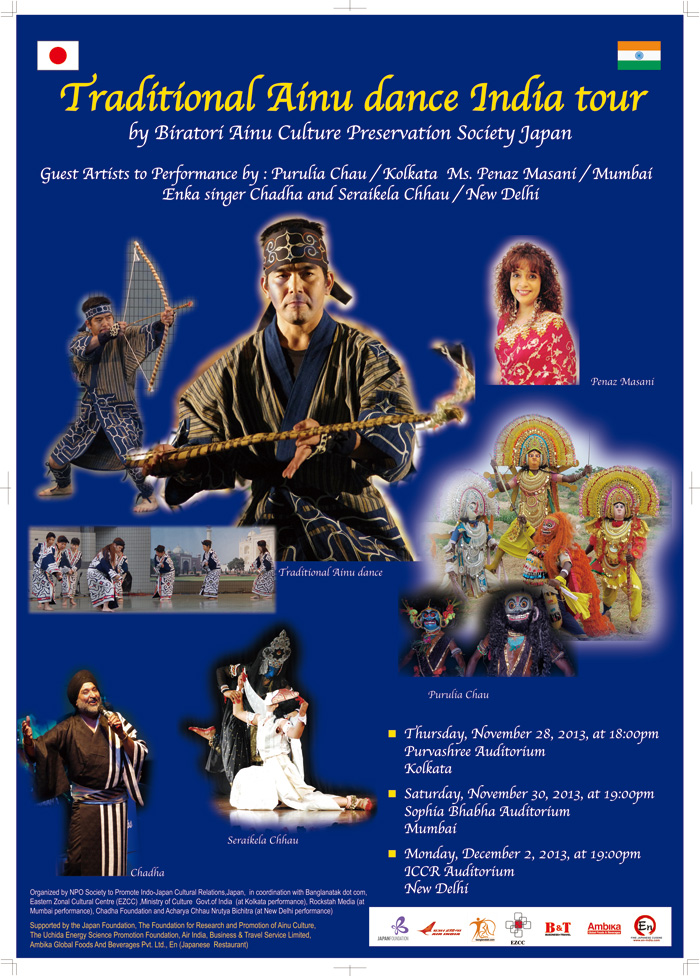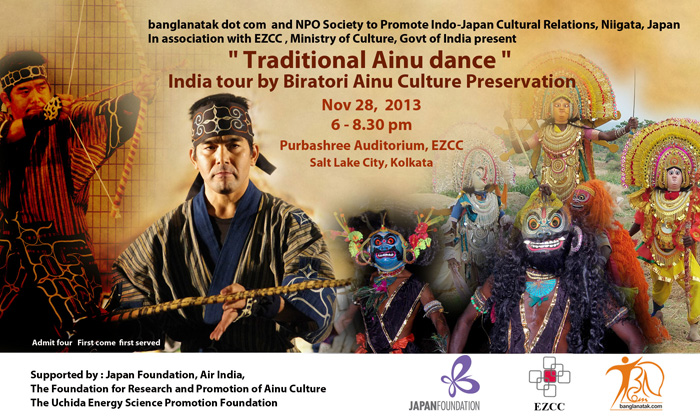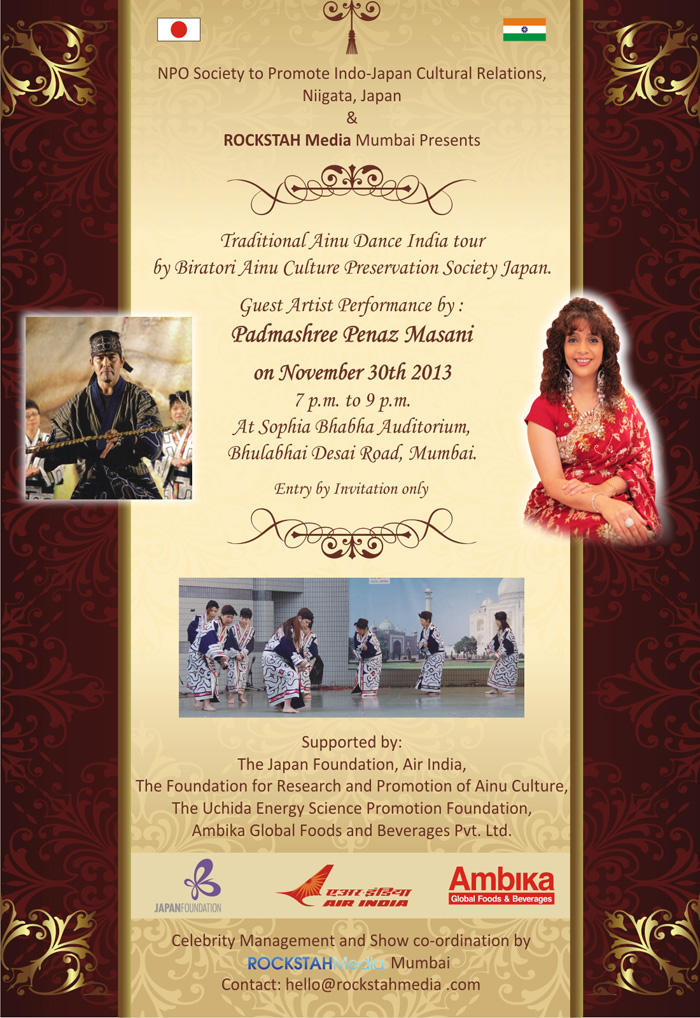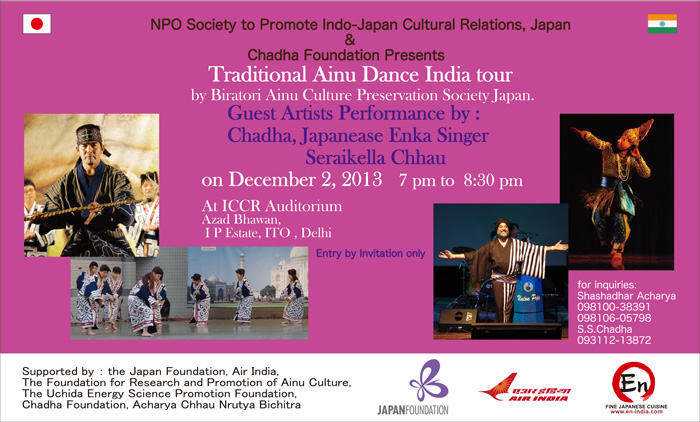Born in Tokyo, 1948, Tokio Hasegawa is a Director of Mithila Museum which has collections of Indian folk arts, Mithila and Warli paintings. He has very unique understanding about the universe and is the prominent figure in promoting cultural exchange between Japan and India. He organizes various cultural events, including Namaste India. He chairs NPO Society to Promote Japan-India Cultural Relation and is an author of "Welcome to the Forest of the Universe" (published by Jiyusha Publishing)
Japan achieved modernization in short period of time in Meiji era. It later became the third largest economy in the world despite the devastation it experienced in the aftermath of WWII. Hasegawa is engaging in very special activity of introducing Indian culture in Japan. Here, we would introduce some of his activities and his personal history to you.
In 1968, Japan was governed by Samurai warriors. Under the pressure from western nations of the time, Japan was forced to lift the national isolation policy which had been in place for more than 200 years to accept Western and American culture. Since the opening of the country, rapid modernization began.
Hasegawa was born in 1948. He is "Edokko", meaning a member of a family who lived in Edo for over certain period of time. He is the 16th generation of such family. After graduating from a high school, Hasegawa started to learn New Jazz, which was popular in America at that time. When he was practicing tenor sax at his small residence in old part of Tokyo, he heard an old man in the neighborhood singing "Dodoitsu", a form of Japanese poetry developed towards the end of Edo period. Hasegawa sensed a piece of civilization in it. "Tatami mat (a mat made with rice straw) here may match with Dodoitsu (which singing style resembles India's gazel), but it does not go well with tenor sax, a metal musical instrument”. Hasegawa also realized that the sound of saxophone was too loud and rather coarse. Hasegawa liked tatami mat. He liked the sound of Dodoitsu. But Dodoitsu sounded rather old. What was the music that would suit him? Hasegawa started journey, seeking for the kind of music he wanted. There was nothing in Japanese society that satisfied him. Hasegawa listened to all kinds of music from the world, but did not feel satisfied. Since, then he started series of experiments to create something new based on the culture Japan cherished before the arrival of western culture with some influence from global music. He learned Buddhist mantra and started to sing impromptu. (Although Hasegawa did not know about Dhrupad back then, his singing style was similar to Dhrupad) In early 1970, he formed an impromptu music performance group, “Taj Mahal Travelers” with other youths who did not quite feel comfortable with the popular music genre of the time, such as modern music, new rock and, in Hasegawa’s case, new jazz. The caravan participated in a one-month music event called “Utopia and Vision” held at National Museum of Modern Art, Stockholm in 1972. After the event in Stockholm, the caravan carried out one-year European tour. During the tour, Hasegawa paid close attention to the flow of air around him and the shadow created by the sun. He showed keen interest in stones and rocks. As soon as he arrived at a town where he was to perform, he used to go out and find himself three large stones and place them on the stage. Then, he would sit with his legs crossed in front of large stones. As a part of his performance, he would bring up one of the stones above his head and bring it down to hit another stone on the stage. Hasegawa would try to feel winds when he lifted a stone above his head. When he felt himself being in a universe, he would drop the stone to hit the other one on the stage. Hasegawa, back then, thought stones were the most beautiful creation on the earth. Hasegawa believed the reason why he found stones beautiful was that the earth was one big stone. Moon, also, was a stone for Hasegawa. He believed that the entire universe was composed of large stones. The other type of performance Hasegawa conducted at his concert was “shadow pulling”. Hasegawa would place a thick rope around the shadow of a tree. Stepping away from the shadow about 10 meters, he would start pulling the rope, thus shadow. Hasegawa says, shadow is an ambassador sent from the universe, representing the universe just like “foreign Ambassadors representing their countries”. In this regard, he believes the most important aspect in Japanese Sado, or tea ceremony, is a shadow of flowers placed inside the tea room. He says so because the shadow created by sunlight, beaming through a window with washi screen, would deliver the universe to the tea room where the host and a guest may meet. Having developed deeper view on the universe, he went back to Tokyo, only to find the place as polluted as today’s Beijing, China. Tokyo was suffering from photochemical smog. And there was no moon. Therefore, Hasegawa decided to live in a mountain of Tokamachi-shi, Niigata, 200 kilometers away from Tokyo. There, he lives with truly beautiful moon. He jokes “I got moon-burn”.
Hasegawa often asks Indians whether they know the reason why Lord Krishna and Lord Shiva have blue faces. Some Indians have no clue. To them, Hasegawa would say “Lord Krishna loves the full moon and he dances with Gopis all the time. This is the reason why Krisha’s face became blue, so if I spent 10,000 years more looking at the full moon, the color of my face may turn blue”.
During his spiritual journey to deepen his view on the universe, Hasegawa was seized by the feeling of loneliness. It snows about 4 meters around Hasegawa’s residence. “As I was immature spiritually, I felt scared being in the mountains. Even a small sound scared me, as if I was being haunted by some ghosts”. Lonely feeling deepened and he found it difficult, even to live. He opened the door and listened to the sound of snowstorm. He kept listening to the sound of the wind, letting his body covered with snow. As he listened, to his surprise, he found the sound of the snowstorm more wonderful than any other music he had listened to and the moon was more beautiful than any paintings he had seen. If it was not for those dull artists, people would not have to visit museums or sit in music concerts.
Couldn’t it be artists who were preventing people to enjoy the real beauty…? Hasegawa kept on thinking such things, but doing so did not heal the feeling of loneliness. One day, a small rabbit hopped across the snowfield in front of him. The rabbit was to pass him by. “As I was feeling so lonely, I was happy to see a wild rabbit in close distance. However, when the rabbit gave a glance to me, I realized there was no feeling of loneliness in rabbit’s eyes. The rabbit, which is constantly exposed to the risk of being killed, just hopped away from me”. For Hasegawa, rabbit became his teacher of life and he became unable to eat his teacher, rabbits. After the encounter, Hasegawa became a vegetarian and has not eaten even eggs, for over 40 years. 10 years after his migration to the mountain, an area development plan was proposed to an area where a large pond called Oike was located. Hasegawa objected to the plan and, as a result, he was to utilize a deserted elementary school building in the area as a cultural facility.
Hasegawa became interested in Mithila paintings when a Japanese boy brought some back to Japan from India. Hasegawa went to India and met Ganga Devi. Upon her request to help her and Mithila arts, Hasegawa established Mithila Museum. Hasegawa looked back on the destiny of Japan’s ukiyoe painting. When Japan was modernizing, Japan lost so many ukiyoe paintings to the West. Japan may have become rich, but is unable to buy back everything they lost. Hasegawa thought his museum may be small, but if he dedicated his museum to collecting Mithila paintings, he may be able to make come contribution to the world. He started to visit India frequently and to gather Mithila paintings that were scattered around India. In 1980s, the late Pupuru Jayakhar praised Mithila Museum collection as an incomparable collection in terms of quality and quantity in the world. Hasegawa was appointed to Assistant Director of Japan Executive Committee for ’88 Indian Festival, a festival jointly organized by Japan and India. (Chairpersons for executive committees in Japan and India were Mr. Goro Koyama, President of Mitsui Bank and Ms. Purpuru Jayakar) Realizing the fact that nationally funded events were only organized in large cities, he organized more events in small and remote islands of Okinawa and remote villages. Hasegawa started to invite Mithila artists to create large paintings, large enough to be exhibited at museums. In total, Hasegawa invited more than 100 artists. They challenged creating something new. Among the artists, one visited Japan for 17 times. The late Ganga Devi also was invited also. About a half of her works in the world are kept at Mithila Museum. Since then, Hasegawa started to play major role in organizing cultural events in Japan when a national event takes place between Japan and India. In Japan-India Exchange year that took place from 2007 to 2008, Hasegawa traveled across Japan with 25 dance and music troupes dispatched by ICCR. They traveled as far as Rishiri, Hokkaido (the most northern part of Japan) to Yonaguni Island, Okinawa (where can see Taiwan), organizing 162 stages and workshops. Hasegawa successfully organized and carried out unprecedented events in Japan and was awarded Japan-India Exchange Year Award by Indian Government.
Responding to India’s open economic policy of 1991, Japan-India Economic Committee and Japan Chamber of Commerce and Industry first organized Namaste India in 1993. They asked Hasegawa, who was the Director of museum and was specialized in Indian art, to support the event from cultural aspect. As the Japanese economy stagnated, JCCI became no longer capable of organizing Namaste India. When there was no one to take over the operation, Hasegawa decided to pick it up. Since then, Hasegawa has shifted the event venue to Yoyogi Park and developed the event to be the largest Indian festival in the world. This year’s Namaste India was held on 28th and 29th of September and the total number of visitors amounted to 200,000. To the opening ceremony of Namaste India last year, Mr. Karan Singh, Chairman of ICCR attended. This year, Mr. Yoshiro Mori, the former PM and 7th Chairman of JIA attended. This year’s Namaste India was specially organized so to celebrate the 110th Anniversary of JIA. At the booth celebrating the 110th Anniversary of JIA, Hasegawa contributed a panel explaining about the beginning of JIA.
Hasegawa wrote feverishly about the encounter and the dialogue exchanged between Eiichi Shibusawa (3rd Chairman of JIA), who is called the god of Japan’s economy and the father of Japan’s capitalism and J. N. Tata and efforts by Shigenobu Okuma, 2nd Chairman of JIA, to support promotion of Japan-India trade politically. Hasegawa wrote how they were able to open a new shipping route connecting Bombay, and how Japan and cotton trade was initiated and contributed greatly to the development of spinning and fiber industry in Japan when Toyota and Sony were not powerful enough to drive Japanese economy. The interchange of Japan and India becomes the opening , and textile industry becomes main industrial one before World War II of Japan .
During the 60th Anniversary of Japan-India Diplomatic Relation celebration last year, Hasegawa organized Oddissi dance at Chumon Gate and Dhrupad performances in front of Great Buddha Statue of Nara at Todaiji Temple in Nara in the memory of Bodisena, the first Indian monk to Japan. (Hasegawa says these historical events were organized and offered to the Great Buddha of Nara by Indian Government on behalf of Bodhisena, 1275 years after his arrival to Japan). Hasegawa organized Buddhist photo exhibition, “the Greatest Journey of Ideas” by Benoy Behl at the same time. Hasegawa organized same events at Todaiji Temple this year as well. He hopes to continue the same events for next ten years. He wishes ministers in charge of cultural affairs from Japan and India may attend his event next year.
Hasegawa says “the Great Buddha of Nara was completed in 752. The Emperor who ordered the construction of the statue was Emperor Jomu. He already retired from the post of emperor and his daughter took it over. As he was bed-ridden, he requested Bodhisenna to conduct eye-opening ceremony of the Great Buddha. He even sent a letter to Bodhisenna pleading him “not to reject my request”. When Bodhisenna was to draw eyes of Great Buddha, the large brush he held had about a thousand thin ropes called rui attached and attendees to the ceremony, including Emperor Shomu, held the other end, hoping to get blessing from the Great Buddha. It is said that about 10,000 monks, musicians and government officials attended the ceremony and the list of monks is still kept at Todaiji Temple. This ceremony could have been said important tens of times higher than Olympics games. Bodhisenna reached Japan from China at second attempt. In the first attempt, he drifted the ocean for sometimes. After reaching Japan, he settled at Daianji Temple near Todaiji Temple and taught Buddhism to Japanese monks. The fact that he conducted this grand national event should be indicated in textbooks of both Japan and India”.
Hasegawa also organized Noh performance by the 26th Kanze School of Noh in Delhi and Bangalore as a part of the 60th Anniversary events. Noh was the first to be recognized as UNESCO’s Intangible Cultural Heritage.
Ainu performance tour in India was not organized so to coincide with the visit by Their Majesties to India from 30th November. The tour date was already decided a year ago. It is pure luck that the tour date coincided with the Imperial visit. During the tour, it is expected that Hasegawa will be supported by various dancers, musicians and related persons who visited and traveled Japan. Hasegawa will be promoting international exchange in his unique way. In each international exchange program Hasegawa plans, pieces of unique messages about creativity, richness, nature and human begins and communication with the universe are scattered, as if his event is like a work of an artist.
Book 『Welcome to the Forest of the Universe』(Jiyusha Publishing)
Mithila Museum 【http://www.mithila-museum.com】
Namaste India 【http://www.indofestival.com】 |

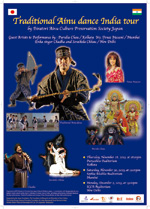 We will be hosting the Ainu dance tour in India from the end of November this year. It is our great pleasure that the timing coincides with the official visit of India by the Japanese Emperor and Empress. The cultural event will serve as a great opportunity for the peoples of India and Japan to further deepen their friendship. We would greatly appreciate it if you could inform this event of as many Indian nationals as possible.
We will be hosting the Ainu dance tour in India from the end of November this year. It is our great pleasure that the timing coincides with the official visit of India by the Japanese Emperor and Empress. The cultural event will serve as a great opportunity for the peoples of India and Japan to further deepen their friendship. We would greatly appreciate it if you could inform this event of as many Indian nationals as possible.